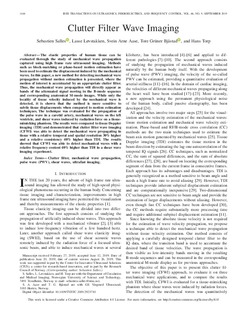| dc.contributor.author | Salles, Sebastien | |
| dc.contributor.author | Løvstakken, Lasse | |
| dc.contributor.author | Aase, Svein Arne | |
| dc.contributor.author | Bjåstad, Tore Grüner | |
| dc.contributor.author | Torp, Hans | |
| dc.date.accessioned | 2020-01-28T09:37:57Z | |
| dc.date.available | 2020-01-28T09:37:57Z | |
| dc.date.created | 2019-08-11T16:59:26Z | |
| dc.date.issued | 2019 | |
| dc.identifier.citation | IEEE Transactions on Ultrasonics, Ferroelectrics and Frequency Control. 2019, 66 (9), 1444-1452. | nb_NO |
| dc.identifier.issn | 0885-3010 | |
| dc.identifier.uri | http://hdl.handle.net/11250/2638257 | |
| dc.description.abstract | The elastic properties of human tissue can be evaluated through the study of mechanical wave propagation captured using high frame rate ultrasound imaging. Methods such as block-matching or phase-based motion estimation have been used to estimate the displacement induced by the mechanical waves. In this paper, a new method for detecting mechanical wave propagation without motion estimation is presented, where the motion of interest is accentuated by an appropriate clutter filter. Thus, the mechanical wave propagation will directly appear as bands of the attenuated signal moving in the B-mode sequence and corresponding anatomical M-mode images. While only the locality of tissue velocity induced by the mechanical wave is detected, it is shown that the method is more sensitive to subtle tissue displacements when compared to motion estimation techniques. The technique was evaluated for the propagation of the pulse wave in a carotid artery, mechanical waves on the left ventricle, and shear waves induced by radiation force on a tissue-mimicking phantom. The results were compared to tissue Doppler imaging (TDI) and demonstrated that clutter filter wave imaging (CFWI) was able to detect the mechanical wave propagating in tissue with a relative temporal and spatial resolution 30% higher and a relative consistency 40% higher than TDI. The results showed that CFWI was able to detect mechanical waves with a relative frequency content 40% higher than TDI in a shear wave imaging experiment. | nb_NO |
| dc.language.iso | eng | nb_NO |
| dc.publisher | Institute of Electrical and Electronics Engineers (IEEE) | nb_NO |
| dc.rights | Navngivelse 4.0 Internasjonal | * |
| dc.rights.uri | http://creativecommons.org/licenses/by/4.0/deed.no | * |
| dc.title | Clutter Filter Wave Imaging | nb_NO |
| dc.type | Journal article | nb_NO |
| dc.type | Peer reviewed | nb_NO |
| dc.description.version | publishedVersion | nb_NO |
| dc.source.pagenumber | 1444-1452 | nb_NO |
| dc.source.volume | 66 | nb_NO |
| dc.source.journal | IEEE Transactions on Ultrasonics, Ferroelectrics and Frequency Control | nb_NO |
| dc.source.issue | 9 | nb_NO |
| dc.identifier.doi | 10.1109/TUFFC.2019.2923710 | |
| dc.identifier.cristin | 1715183 | |
| dc.relation.project | Norges forskningsråd: 237887 | nb_NO |
| dc.description.localcode | This work is licensed under a Creative Commons Attribution 4.0 License. For more information, see http://creativecommons.org/licenses/by/4.0/ | nb_NO |
| cristin.unitcode | 194,65,25,0 | |
| cristin.unitname | Institutt for sirkulasjon og bildediagnostikk | |
| cristin.ispublished | true | |
| cristin.fulltext | original | |
| cristin.qualitycode | 1 | |

